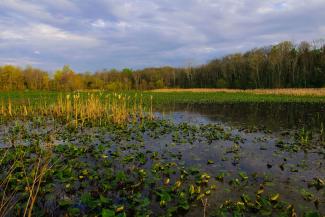The Environmental Law Institute (ELI) is pleased to announce the winners of the 33rd Annual National Wetlands Awards: John R. White, Jessica Hua, Mark Laska, Zachariah Perry, and Mick Micacchion. Together, these awardees have restored, researched, and protected thousands of acres of wetlands nationwide; their examples have inspired many members of their community to act and make a difference to protect and improve these vital natural resources.
ELI will honor these five wetlands champions during an Awards Ceremony on May 19th at the National Academy of Sciences and via a month-long digital campaign throughout May, which is National Wetlands Month. As part of this campaign, ELI has invited our awardees to contribute their unique perspectives on wetlands protection to a post for ELI’s Vibrant Environment blog. Today’s piece features contributions from Mick Micacchion, winner of the Wetlands Program Development category.
When I was a kid, I always found myself wanting to spend time in the fields and forests near our house. The forested areas that held water intrigued me, and I was drawn to them by the sound of amphibians in the spring. At first, it was seeing the frogs and trying to catch them by hand that brought me back to these habitats. But when I saw my first salamander larvae in the water, I was completely taken by these unique ecosystems that I later learned were wetlands. My childhood friends would join me exploring them and they too found wetlands to be extremely interesting.

Throughout my younger years, I continued to spend a lot of my free time in the natural world. It was during this time when I decided I wanted to be a biologist. In high school, biology was my favorite course, and I went to college to pursue a degree in wildlife management. I obtained my master’s degree in wildlife management and later began working for the Ohio Environmental Protection Agency as a wetland ecologist. There, I was surrounded by colleagues who shared my interests—protecting the earth was on everyone’s agenda.
As a wetland ecologist, I worked with others in the Wetland Ecology Group to better understand the ecology of Ohio’s wetlands. To do this, we developed assessment tools for wetland flora, fauna, and habitats. When Ohio EPA decided to develop water standards for wetlands, we were able to further our studies and understanding of wetlands to set up a rule package geared toward protecting wetlands at the highest level possible.
In the Ohio’s Wetland Water Standards, wetlands are broken into three categories based on quality. Category 1 are of poor quality, Category 2 of fair to good quality, and Category 3 of excellent quality. The higher the quality, the more protection the rules provide to the wetlands. As part of the rulemaking process, I developed the Amphibian Index of Biotic Integrity, which measures the quality of vernal pools and places wetlands into three categories using an amphibian community perspective. This assessment tool is based on data we collected on hundreds of Ohio’s vernal pools.
The rules require applicants to verify that there are no alternative locations where their projects could be constructed without impacting wetlands. If a wetland is impacted, it must be replaced through mitigation by a wetland of the same type and of equal or higher quality. While not every wetland in the state can be protected, the rules do add a high degree of protection to our most ecologically valuable wetlands.
I truly enjoyed working with others to develop and add protections for wetlands in Ohio. It was also a great opportunity to put my childhood interest in nature and amphibians to good use. I retired from Ohio EPA in 2011 and since have worked for the Midwest Biodiversity Institute and The Nature Conservancy. At those organizations, I have continued to learn more about the ecology and protection of wetlands, especially those that cannot be replaced at anywhere near the level of quality they currently exhibit.
I believe it is important to educate people about wetlands. Throughout my career, I have focused on vernal pool wetlands—and I know most people are unaware of their existence and importance. I work with the Ohio Vernal Pool Network to hold gatherings to explain the ecology of vernal pools through presentations. Attendees even get to see them up close when they join us for a hike around and into a local vernal pool. This is an exciting way to introduce people to vernal pools, and in most years we are able to show them live adult salamanders and frogs. We can also give them glimpses of salamander and frog egg masses. There is no replacement for showing attendees—in person—salamanders and frogs that are seasonal residents of the local vernal pool. Adults and children will recall these memories and become motivated to protect vernal pools for the rest of their lives. I am appreciative and proud to have been involved in wetland and vernal pool education and protection.
